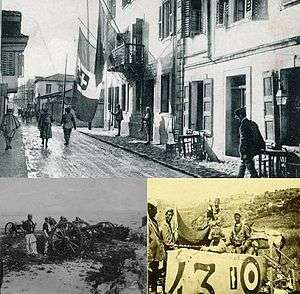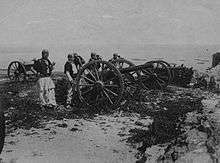Vlora War
| Vlora War | |||||||||
|---|---|---|---|---|---|---|---|---|---|
 Clockwise from top: Italian base; Albanian soldiers; Italian cannons captured by Albanian irregulars during one of the battles | |||||||||
| |||||||||
| Belligerents | |||||||||
|
|
| ||||||||
| Commanders and leaders | |||||||||
|
|
| ||||||||
| Strength | |||||||||
|
4000 (early) 10,000 (later)[1] |
15,000 infantry 200 artillery[1] | ||||||||
| Casualties and losses | |||||||||
| 3000 casualties | 2000-3000 casualties[2] | ||||||||
The Vlora War or the War of 1920 (Albanian: Lufta e Vlorës or Lufta e Njëzetës; Italian: Guerra di Valona) was a series of battles between Italian forces garrisoned throughout the Vlorë region and Albanian nationalists, who were divided into small groups of fighters. The war lasted three months and had great impact in the struggle of Albania for the safeguard of its territories while Albanian borders and future were discussed in the Paris Peace Conference. The Vlora War is seen as a turning point in the establishment of the Albanian independence.[1]
Background
Before entering the First World War as an ally of Triple Entente the Kingdom of Italy had signed the secret Treaty of London: Italy promised to declare war against Germany and Austria-Hungary within a month in exchange of some territorial gains at the end of the war. The promised territories of Albania to Italy were treated in Articles 6 and 7 of the treaty:[3]
Article 6 Italy shall receive full sovereignty over Valona, the island of Saseno and surrounding territory....
Article 7 Having obtained the Trentino and Istria by Article 4, Dalmatia and the Adriatic islands by Article 5, and also the gulf of Valona, Italy undertakes, in the event a small, autonomous, and neutralized state being formed in Albania Italy not to oppose the possible desire of France, Great Britain, and Russia to repartition the northern and the southern districts of Albania between Montenegro, Serbia, and Greece. The southern coast of Albania, from the frontier of the Italian territory of Valona to Cape Stilos, is to be neutrazied. The Italy will be conceded the right of concluding the foreign relations of Albania; in any case, Italy will be bound to secure for Albania a territory sufficiently extensive to enable its frontiers to join those of Greece and Serbia to the west of Lake Ochrida ..
In 1920 in allies in the Paris Peace Conference had still reached no decision on Albania's future, but Italy's claims to sovereignty over Vlorë had never been seriously challenged. Italian Prime Minister Francesco Saverio Nitti had also hoped to obtain a mandate over the rest of the country according to the secret Treaty of London.[4]
Course of war
The war started on June 4, after Italian General Settimo Piacentini refused to hand over the Vlora district to the Albanian government. Albania had previously forced much of the italian occupation to leave the country, but after demands by Ahmet Zogu, the then interor-minister of Albania, to continue the evacuation was rejected by Italy, the albanians announced the establishment of the National Defense Committee under the leadership of Qazim Koculi and began to gather volunteers.[1] Ahmet Lepenica became the commander in chief of the detachment consisting of around 4000 men. The Albanian insurgents were poorly armed and not everyone even carried a gun, some were armed with nothing but sticks and stones. In and around Vlora was around 15,000 Italian soldiers who were stationed in the area with artillery.[1]
The Albanians engaged in fighting in the Vlora region and soon the rebels were bolstered by volunteers in the region. This increased the size of the force to the official number of 10,000 irregulars, which also included the Banda e Vatrës, an Albanian military band that was formed in the United States that travelled 23 days by boat from the US to Durrës.[5][1] The advance of the Albanian troops as well as communist revolutionary movements and riots within the army in Italy made reinforcements to the italian soldiers in Vlora impossible.[6][1] Morale crumbled among the italian soldiers barricaded inside Vlora, without orders and with malaria and communist agitation spreading among the ranks.[1][6]
On August 2, 1920, the Albanian-Italian protocol was signed under which Italy would retreat from Albania. That ended Italian claims for Vlora and a mandate over Albania, rescuing the territory of the Albanian state from further partition. A ceasefire was announced on August 5, ending all Italo-Albanian hostilities.
Orders of battle
Albanian order of battle
| Albanian order of battle | |||||
|---|---|---|---|---|---|
| Forces from Shullëri | Commander Kalo Telhai | ||||
| Forces from Kutë | Commander Rrapo Çelo and Halim Rakipi | ||||
| Forces from Dukat | Commander Sheme Sadiku and Hodo Zeqiri | ||||
| Forces from Lumi i Vlorës | Commander Sali Vranishti | ||||
| Forces from Fëngu | Commander Muço Aliu | ||||
| Forces from Kanina | Commander Beqir Velo | ||||
| Forces from Salari | Commander Selam Musai | ||||
| Forces from Kurvelesh | Commander Riza Runa | ||||
| Forces from Fterra | Commander Xhaferr Shehu | ||||
| Forces from Mallakastër | Commander Bektash Çakrani and Halim Hamiti | ||||
| Forces from Skrapar | Commander Riza Kodheli | ||||
| Forces from Berat | Commander Seit Toptani and Izedin Vrioni | ||||
| Forces from Peqini | Commander Adem Gjinishi | ||||
| Forces from Gjirokastër | Commander Javer Hurshiti and Xhevdet Picari | ||||
| Forces from Çamëria | Commander Alush Seit Taka and Muharrem Rushiti | ||||
| Forces from Korça | Captain Ferit Frashëri and Tosun Selenica | ||||
| Forces from Tirana | Captain Ismail Haki Kuçi | ||||
| Albanian-American Volunteers | Captain Aqif Përmeti and Kareiman Tatzani | ||||
Italian order of battle
| Italian order of battle | |||||
|---|---|---|---|---|---|
| Area | Military Strength | Commander | |||
| Vlorë-Kaninë area | Center of High Command of 36th division forces | Commander: General Settimo Piacentini. Division commander - General Emanuele Pugliese and his aid General De Luca. | |||
| Kotë | Road, food and hospital center. 4th command of mixed artillery. Alpine battalion, 72nd battalion of Infantry. | Command of Carabinieri forces. Commander General Enrico Gotti, Commander of the garrison Cavallo Michele. | |||
| Gjorm | Center of a machine gun company | Commander Captain Bergamaschi | |||
| Matohasanaj Castle | 72 infantry battalion, infantry regiment, 182nd mountain artillery section 70 mm. | Commander major | |||
| Tepelenë Castle | Infantry battalion, 157th artillery section, carabinieri forces. | Commander major Bronzini. | |||
| Llogara Pass | Part of 35th battalion of 35th regiment of bersaglieri, 105th repart. | Commander Captain Boansea | |||
| Himarë | Center of command of 35th regiment of bersaglieri. | Commander general Rossi, Colonel Manganeli. | |||
| Selenicë | Commander major Guadalupi | ||||
| Vlora Gulf | Battleships "San Mario", "Bruceti", "Dulio", Alkina" Orion, torpedinier "Arcione" | ||||
| Ujë i Ftohtë region (outskirt south of Vlorë) | Aviation forces | ||||
| Panaja | Central magazines of the Italian army | ||||
| Vajzë - hospital and post command. | |||||
Ç’është kështu që dëgjojmë
vaj medet o Vlora jonë
italianët po zbarkojnë
me pampor e me ballonë
jo mor jo nuk e durojmë.
Ngrihi shokë të sulmojmëVlorën tonë ta çlirojmë.
What is this that we hear
Alas, oh our Vlora,
The Italians are landing
With ships and airplanes,
No we won't take it.
Stand up friends, to attackTo liberate our Vlora.
Armistice

After three months of warfare, an armistice agreement was signed between the Italian and the Albanian governments. It had these main points:
- The Italian Government completely acknowledged the independence, territorial integrity, and sovereignty of Albania, within the frontiers defined in 1913 by the Conference of Ambassadors in London.
- The Italian government relinquished its protectorate proclaimed in 1917 and the occupation and administration of Vlorë and its hinterland, and renounced all claims against Albania and all interference in Albanian political affairs, and abandoned the idea of a mandate over the country.
- The Italian government agreed to withdraw its war materials from Vlorë and its hinterland, to evacuate all its holdings on the Albanian mainland, and to repatriate at an early date the Italian troops actually stationed in Vlorë and on the littoral, and all its forces still remaining in other parts of Albanian territory with the exception of the garrison on the island of Sazan at the entrance of the Vlorë bay; Italy retained the permanent possession only of the island of Sazan, but remained in temporary occupation of Cape Linguetta and cape Treporti, both dominating Vlorë bay, with the right to fortify them; the detachment of troops at Shkodër was also to remain in that town.
- There would take place an exchange of prisoners, the liberation of arrested persons under a general mutual amnesty, and the settlement of outstanding questions concerning the private interests of Albanian and Italian subjects.
It was the first diplomatic pact between Albania and a foreign power. Albania had used all its influence to obtain full and unreserved recognition by the Western powers of the independence of Albania within 1913 borders.[7]
References
| Wikimedia Commons has media related to Vlora War. |
- 1 2 3 4 5 6 7 8 Albanian identities: myth and history Authors Stephanie Schwandner-Sievers, Bernd Jürgen Fischer Editors Stephanie Schwandner-Sievers, Bernd Jürgen Fischer Edition illustrated Publisher C. Hurst & Co. Publishers, 2002 ISBN 1-85065-572-3, ISBN 978-1-85065-572-5
- ↑ Hugh Montgomery-Massingberd, editor, Burke's Royal Families of the World, Volume 1: Europe & Latin America (London, UK: Burke's Peerage Ltd, 1977), page 106
- ↑ Southern Albania, 1912-1923 Publisher Stanford University Press ISBN 0-8047-6171-X, 9780804761710 p.61
- ↑ Italy from liberalism to fascism, 1870-1925 Author Christopher Seton-Watson Edition illustrated Publisher Taylor & Francis, 1967 ISBN 0-416-18940-7, ISBN 978-0-416-18940-7 p. 578
- ↑ "BANDA DHE VULLNETARËT E VATRËS NË LUFTËN E VLORËS DHE NË KONFLIKTIN ME GREKËT NË KUFIJTË JUGORË". gazetadielli.com. Retrieved 21 March 2018.
- 1 2 "Gli Italiani si ritirano dall'Albania". digilander.libero.it. Retrieved 21 August 2018.
- ↑ Albania and King Zog: independence, republic and monarchy 1908-1939 Volume 1 of Albania in the twentieth century, Owen Pearson Volume 1 of Albania and King Zog, Owen Pearson Author Owen Pearson Edition illustrated Publisher I.B.Tauris, 2004 ISBN 1-84511-013-7, ISBN 978-1-84511-013-0 page 151
Further reading
- Akademia e Shkencave e RPSSH "Fjalori Enciklopedik Shqiptar", Tirana, 1985.
- Jacques, Edwin. Shqiptarët: Historia e popullit shqiptar nga lashtësia deri në ditët e sotme. Trans. Edi Seferi. Tirana: Mcfarland, 1995.
- Pearson, Owen. Albania in the Twentieth Century: A History. Volume One. New York: I.B. Tauris, 2006 ( ISBN 1-84511-013-7).
